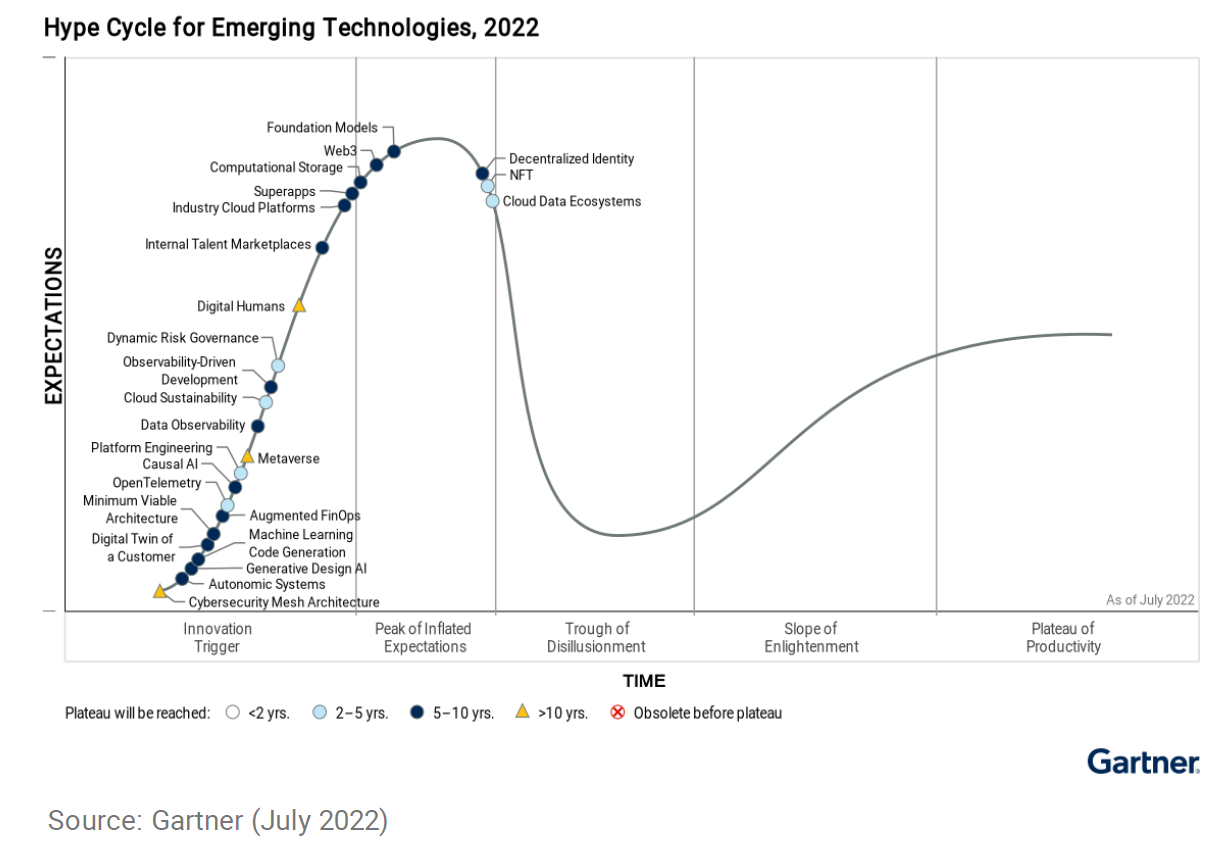Our monthly innovation updates provide you with an overview of the most relevant insights, best practices & tools from the innovation cosmos.
1. Gartner® Hype Cycle for Emerging Technologies, 2022
The Hype Cycle for Emerging Technologies is probably one of Gartner's best-known and most eagerly awaited annual publications. The recently published 2022 edition once again holds some surprises about the must-known trend and technology developments of the future.
According to Gartner:"As a technology innovation leader, CTO or CIO, you must follow emerging technologies and applied frameworks to determine their impact on your industry and the opportunities they present for your organization. This year brings exciting opportunities to explore in your search for technology-enabled business transformation."
Gartner sees three overarching themes, along with the top 25 technology trends grouped under them, that are expected to have a major impact on business and society over the next two to ten years. More importantly, they will enable innovation and technology executives to drive digital transformation in their organization.
“All these technologies are at an early stage, but some are at an embryonic stage, and great uncertainty exists about how they will evolve. The embryonic technologies present greater risks for deployment but potentially greater benefits for early adopters, which differentiates them from Gartner’s top strategic technology trends,” says Melissa Davis, VP Analyst at Gartner.
- Accelerated AI Automation
Expanding AI use is a critical way to drive the development of new products, services, and solutions. Among other things, this means accelerating the creation of specialized AI models, applying AI to the development and training of AI models, and leveraging it in the delivery of products, services, and solutions. The result is more accurate predictions and decisions and faster delivery of expected benefits.
Some of the key technologies listed by Gartner include: autonomic systems, causal AI, foundation models, generative design AI, and machine learning code generation.
- Optimized Technologist Delivery
This theme addresses the key constituents in building a digital business. A number of emerging technologies focus on product, service, and solution developer communities, and the platforms they use. These technologies provide feedback and insights that optimize and accelerate the delivery of products, services, and solutions and increase the sustainability of business operations.
Some of the emerging technologies identified by Gartner as relevant here include: augmented FinOps, data observability, industry cloud platforms, and dynamic risk governance.
- Evolving and Expanding Immersive Experiences
The future of digital experience is immersive, and the demand for digital environments and ecosystems is growing exponentially. Several emerging technologies support such experiences through dynamic virtual representations of customers and people and new forms of user engagement. These technologies enable individuals to control their identities and data and experience virtual ecosystems. The integration of digital currencies into these worlds is also on the rise.
Some of the key technologies that organizations should stay on top of are: metaverse, non-fungible tokens (NFTs), super apps and Web3, decentralized identity, digital humans, digital twin of the customer, and internal talent marketplaces.
Get your exclusive copy!
Download the Gartner Hype Cycle for Emerging Technologies, 2022, today and discover the technologies that will affect business and society over the next two to ten years.
2. How to encourage innovation among your employees
Fostering an innovation culture within an organization helps companies to remain competitive and avoid the risk of stagnating. A recent article from Alex Goryachev, WSJ best-selling author, highlights nine steps that help to inspire your employees to innovate:
1. Secure executive support.
Leaders from the C-suite must embed and actively reinforce innovation in the corporate strategy by communicating and fostering an environment where employees feel empowered to take risks without consequences.
2. Encourage transparent communications.
Management should communicate their commitment to innovation activities throughout the organization through internal channels (intranet, social media, all-hands meetings, company newsletters, etc.) and encourage employees to share insights with management and with one another. Moreover, it’s important to provide employees with the necessary channels, such as a digital collaboration platform, to exchange knowledge and invite colleagues to evaluate ideas.
3. Open innovation to everyone.Innovation programs are no longer the domain of departments traditionally tasked with innovation, such as engineering, R&D, or product development. Organizations that encourage a culture of collaboration and innovation among all levels of employees are likely to benefit from diverse perspectives that reflect the diversity of their customer base.
4. Embrace diversity and inclusion.
The value of diversity can be harnessed by breaking down silos and encouraging employees from different departments to work together. The spectrum of diversity ranging from gender, skill levels, ages, geographies or industries, or simply individuals with different points of view can add elevate perspective and add a new dimension to innovation.
5. Provide the right spaces and places.
Establish or designate spaces that encourage innovative thinking and help employees to get outside their normal working environment and into an innovative mindset.
6. Make innovation fun with gamification.
Drive participation in innovation activities by incentivizing employees and teams to identify and develop new ideas through competitions, commenting and voting on ideas, and starting discussions with others.
7. Emulate a startup.
Often viewed as progressive, startups are more agile than their corporate counterparts regarding innovation. To emulate a startup environment, employees can play the role of founders, angel investors, and mentors to develop ideas further.
8. Branch out into the community.
Innovation does not happen in a vacuum. To strengthen innovation in your organization, you need both the support of your employees and a variety of partners, such as customers, startups, developers, researchers, and universities. You can achieve more beneficial results when diversified expertise from internal and external stakeholders comes together to collaborate.
9. Instill innovation within your workplace culture – every day.
Promote entrepreneurial thinking by consistently reinforcing core messages about incorporating innovation into daily practices. By giving your employees the time, resources, and opportunities to develop new ideas, and enable them to collaborate, you can ensure that your company remains innovative and relevant in a rapidly changing digital age.
Innovation mistakes to avoid:
- Prioritizing quantity over quality of ideas
- Always following the bottom-up mentality
- Rushing the process
- Mistaking creativity for innovation
Assess your internal innovation mindset and capabilities today and discover which areas your company could improve in!
Want to hear more from Alex Goryachev? Listen to his episode “Innovate or Die: Going Beyond the Buzzword” in our Innovation Rockstars podcast.
3. Our tech of the month: Hyperloop
The promises and pitfalls of hyperloop technology have been debated for the past decade since Elon Musk resurfaced the concept originally developed in 1799 by inventor George Medhurst who pioneered the use of compressed air for propulsion.
This disparity is evident in headlines from just the past few weeks—with trade publication New Civil Engineer touting “Transport is now just ‘years away’ from the ‘age of hyperloop’” in contrast to The New York Times questioning, “Is the Hyperloop Doomed?”
The truth is likely somewhere in between. The fully-realized potential of hyperloop is thrilling and transformative, while at the same time, issues around costs, safety, and real-world practicability persist. Research and development (R&D) is advancing rapidly to overcome hyperloop’s technical limitations, but barriers related to economics, regulation, and social acceptance could threaten its future if left unaddressed.
Hyperloop technology is a form of vacuum-tube transportation capable of connecting mobility hubs using levitating pods that travel through low-pressure tubes at ultra-high speeds. The system uses magnetic levitation and electromagnetic propulsion with low aerodynamic drag to achieve a traveling speed of up to 760 miles per hour.
There is a need for government support in terms of regulation and subsidies or incentives due to the high cost of implementation. Net-zero commitments in many nations could help further encourage investment into and adoption of the technology because it runs on electricity that renewable sources like solar can power.
Some developers are changing strategies in the short term due to safety and regulation obstacles. Earlier this year, Virgin Hyperloop cut several jobs as it shifted focus from transporting passengers to freight. The company, formerly known as Hyperloop One, is already in discussion with potential customers, including the Saudi Arabian government, to deliver a cargo version of the hyperloop.
At the same time, however, there are notable advancements in the passenger version. Canadian-French company TransPod recently announced plans to build a fully-electric plain-train hybrid based on hyperloop principles, capable of connecting cities throughout the country. TransPod has secured USD 550 million in finance for the project—though it is still in the R&D phase, focusing on environmental assessment and land acquisition.
Hyperloop has the potential to create a future of rapid and sustainable transport between cities, reducing travel times and transport-related energy demands to a fraction of their current figures. R&D is underway to scale hyperloop technology which could disrupt the cargo and railway industries with its rapid speed, energy efficiency, and cost-effectiveness. Hyperloop could connect regions that have previously not been commercially viable and could give rise to new shipping routes, impacting logistics and supply chains and playing a pivotal role in the delivery ecosystem.
To explore more technologies like Hyperloop related to the future of transportation, check out the Automotive Technology Radar containing 36 solution drivers that organizations are leveraging to usher in a new era of sustainable, accessible, autonomous, and seamless mobility.
4. Fact of the Month: European Innovation Scoreboard 2022
On 22 September, the European Innovation Scoreboard 2022 was released. It provides a comparative analysis of innovation performance in EU countries, other European countries, and regional neighbours. It helps countries assess the relative strengths and weaknesses of their national innovation systems and identify challenges that they need to address.
Check out the EIS interactive tool and navigate through the map!
Key insights:
- Sweden continues to be the best performer in the EU. Other innovation leaders are Finland, Denmark, the Netherlands, and Belgium.
- Ireland, Luxembourg, Austria, Germany, Cyprus, and France are strong innovators, performing above the EU average.
- Estonia, Slovenia, Czechia, Italy, Spain, Portugal, Malta, Lithuania, and, Greece are moderate innovators.
- Hungary, Croatia, Slovakia, Poland, Latvia, Bulgaria, and Romania are emerging innovators.
5. Your Monthly Dose of Innovation
If you are always on the lookout for new sources of inspiration, check out this list of the 100 best innovation blogs – among the best 50, you will also find the ITONICS Innovation Blog 🙌👉 100 Best Innovation Blogs by FeedSpot








